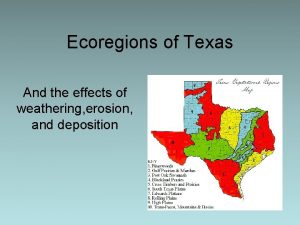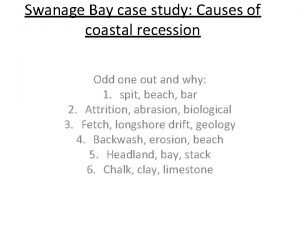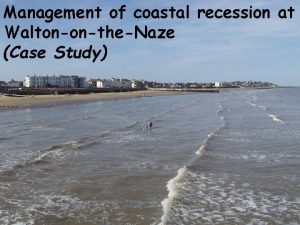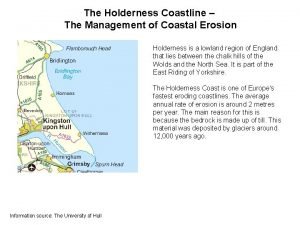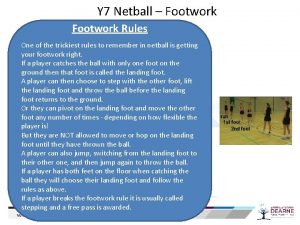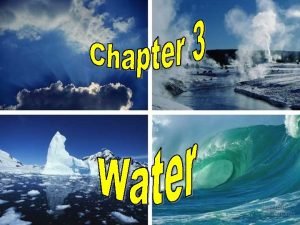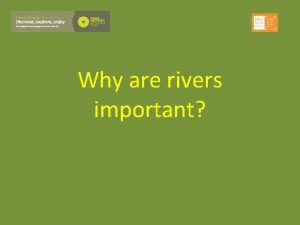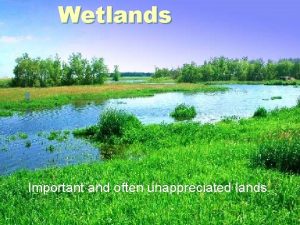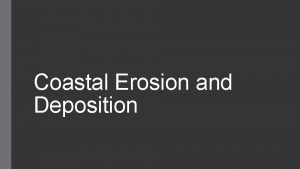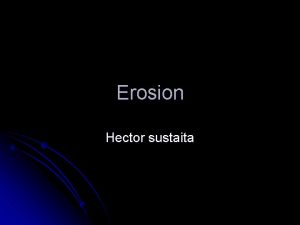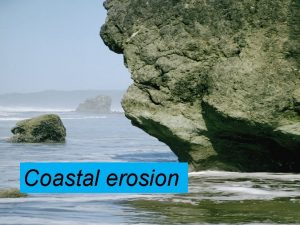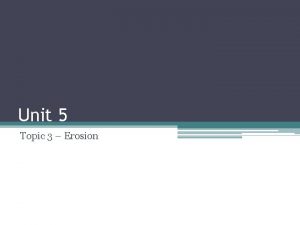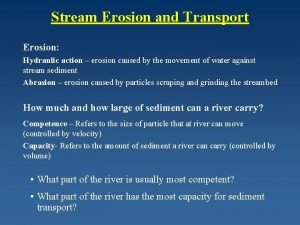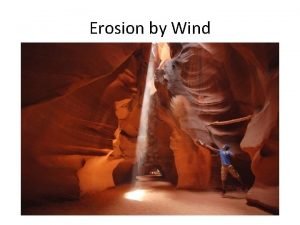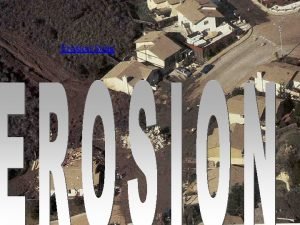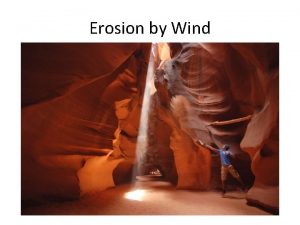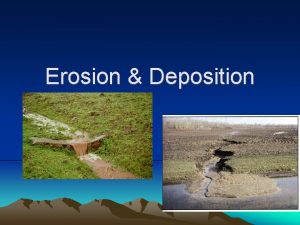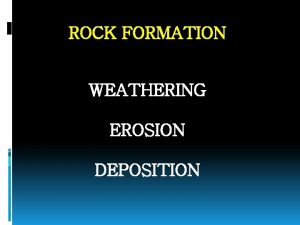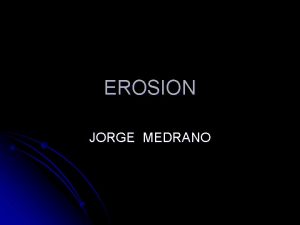Managing Coastal erosion Why is coastal management important






































- Slides: 38

Managing Coastal erosion

Why is coastal management important? • It is becoming increasingly important for councils and governments to start managing coastlines in order to protect them from increasing coastal erosion and flooding due to altering sea levels. • In last week’s Power. Point you saw the devastating effects of coastal erosion when it is not managed.

Why is coastal management important? • The reason for coastal management is obvious, to protect homes and businesses from being damaged and even destroyed by coastal erosion or flooding. Failure to do so can have severe economic and social effects, especially along coastlines which are used for tourism and industry (pretty much all of them). • Management of coastlines is also important to help protect natural habitats. • Government and the European Union provide money to pay for coastal management and this work is normally carried out through ‘The Environment Agency’ and the local council of that area. However, this can sometimes be a slow process as coastal management is very expensive. There is only so much money given out each year to help with this.

How do we protect our coasts? • To protect our coasts, we use hard engineering management. Hard engineering management involves using artificial structures, that usually means man made structures. • To protect our coasts, we also use soft engineering management as it is a more sustainable and natural approach to manage coastal erosion.

Coastal erosion and wave action. • Waves are caused by the force of the wind "pushing" on the water surface. The stronger the wind, the bigger the waves. In bodies of water, such as the ocean, there are frequent waves. The intensity and movement of waves is complicated, they can move up and down, sideways and so on. https: //www. youtube. com/watch? v=c. Yes. EAO Ldhc

Days at the beach • We can all imagine being at the beach on a warm, sunny day with little or no breeze. If we were to paddle in the water, the water would gently roll over our feet. On a day like this the wave has less energy, this is because the wind is not present. • On days when we have no energy, we don’t feel like doing anything and would prefer to walk somewhere rather than run somewhere.


A day at the beach. • Now imagine going to the beach on a windy day. The first thing you might notice is that the red flags will be flying, this warns people not to go into the water, because the sea is rough. There is a difference in the wave movement on a day like this, you might see it crashing on to the rocks, over a pier, into a lighthouse or even over the promenade where people are walking. This is because the wave has lots of energy, more power. • On days like this, when we have lots more energy, we have so much energy that we can run really fast, again and again. Imagine how much energy you have on sports day! • But that wave energy can cause lots of damage over time.


Some time later, there was enough energy in the waves to take the train line back out to sea with it. ( No one was hurt)

Storms hit Porthlevan in Wales • https: //www. youtube. com/watch? v=c. Yes. EAO Ldhc

Long shore drift • https: //www. youtube. com/watch? v=U 9 Eh. Va 4 Mm. Es

Sea defences • Coastal management is about defending the land against a destructive sea. We have seen in the previous slide, what a series of powerful waves can do. Waves so powerful that they ripped the metal train line out of the earth and took the concrete base with it. This left a gaping hole between the remaining railway lines. It was several weeks, before the weather was calm enough for workmen to repair this and get the trains running again.

Soft Engineering Management consists of. . . • • • Beach nourishment Land management Marshland creation Beach stabilisation Break waters Tidal Barriers

Beach Nourishment • This is where sand shingle are added to a beach in order to make it wider. This increases the distance a wave has to travel to reach the cliffs and so the wave will lose more energy and have less erosive power when it reaches the cliffs. The sand shingle has to be obtained from elsewhere and is normally obtained from dredging.

Beach nourishment at Hayling using a dredger.

Land management • Land management is often used to help protect and rebuild dunes. Sand dunes act as a good barrier against coastal flooding and erosion and they can be used as a natural defence against the sea. In order to do so though, the dunes must be left relatively undisturbed so boardwalks are constructed and sections of sand dune systems are marked as out of bounds to the general public in order to reduce the erosion of the dunes by humans.

Land management at Bamburgh

Marshland • Marshland can be used to break up the waves and reduce their speed, reducing the waves erosive power. The marshlands also limit the area which waves can reach preventing flooding. The marshlands can be created by encouraging the growth of marshland vegetation such as glassworts.

Salt marsh plants are vital to reduce coastal erosion and flooding at Orplands, Essex

Beach stabilisation • The goal of beach stabilisation is the same as beach nourishment’s goal, to widen the beach and dissipate (slow down or lose) as much wave energy as possible before it reaches the cliffs. Beach stabilisation involves planting dead trees in the sand to stabilise it and lower the profile of the beach while widening the beach too.

Cornish people bring their old Christmas trees to the beach to stabilise the sand.

Hard engineering consists of. . . • • • Sea walls Groynes Gabions Revetments Riprap

Sea walls are exactly that. Giant walls that span entire coastlines and attempt to reduce erosion and prevent flooding in the process. They’re big, ugly and very expensive requiring constant maintenance so that they don’t fail. They also produce a strong backwash in waves which undercuts the sea wall making their long term sustainability questionable. Traditionally, sea walls are large flat walls however more modern sea walls have a curved structure that reflects waves back into incoming waves, breaking them up and further reducing erosion.

Sea wall in Scarborough

Groynes • Groynes are relatively soft hard engineering techniques. They’re low lying wooden walls that extend out to sea. The idea of groynes is to capture sand that moves down the beach via longshore drift and help build up a larger section of beach in front of an area that’s experiencing coastal erosion. The new beach will increase the distance that waves have to travel to reach the coast and, in the process, they’ll lose most of their energy, reducing their impact. Groynes are pretty effective but they have one major drawback. Groynes will remove a lot of the sand that’s present down-drift of the beach which will result in a thinner beach at this area. This, in turn, means that sections of the coast will be more exposed to erosion down drift of the groynes which can create new problems relating to coastal management. https: //www. youtube. com/watch? time_continue=1&v=u. RPu. HNvh Sm 0&feature=emb_logo

Groynes on south coast beaches

Gabions • Gabions are quite simply bundles of rocks in a metal mesh. They’re placed at the base of a cliff in an attempt to reduce the impact of waves on the cliff and prevent the cliff from being undercut. They’re not particularly effective and they’re quite unsightly but they’re cheap.

Gabions in Suffolk

Revetments • Revetments are concrete (or in some cases wooden) structures that are built along the base of a cliff. They’re slanted and act as a barrier against waves not too dissimilar to a sea wall. The revetments absorb the energy of the waves, preventing the cliffs from being eroded. Revetments can be modified so that they have rippled surfaces, which further help to dissipate the wave energy. Revetments are normally successful at reducing coastal erosion but they are expensive to build. Once built however, they don’t require as much maintenance as a sea wall.

Revetments at Blackpool

Riprap • Riprap are just rocks and stones that have been put against the base of a cliff. They’re similar to gabions in their purpose but they aren’t bound together in a mesh. This makes them look slightly more appealing as they blend into the environment better however the rocks are susceptible to being moved by the sea.

Rip Rap at Withernsea

Breakwaters • Breakwaters are offshore concrete walls that break incoming waves out at sea so that their erosive power is reduced to next to none when they reach the coast. Breakwaters are effective but they can be easily destroyed during a storm and they don’t look particularly nice.

Break waters

Tidal Barriers • Big, retractible walls built across estuaries that can be used as a floodgate to prevent storm surges. They’re hugely effective but they’re also hugely expensive.

Tidal Barrier – The Thames Barrier.

Assignment 1 Coastal defences Choose a hard engineering coastal defence. E. g sea walls, groynes, gabions, revetments or riprap Make a poster about one of these defences, using drawings, pictures or/and diagrams and explain how it works or Create a model of a sea defence and then write out an explanation about how it works. Take a picture of your work, copy/paste it onto the assignment sheet and upload into google classroom please. This work needs to be marked by your teacher.
 Trans pecos deposition
Trans pecos deposition Edwards plateau weathering erosion deposition
Edwards plateau weathering erosion deposition Transportation rocks
Transportation rocks Difference between rill erosion and gully erosion
Difference between rill erosion and gully erosion Pictures
Pictures Why is time management important
Why is time management important Why is performance management important?
Why is performance management important? Why is performance management important?
Why is performance management important? Types of corporate strategies
Types of corporate strategies Importance of strategic management
Importance of strategic management The importance of hrm
The importance of hrm Don't ask why why why
Don't ask why why why From most important to least important in writing
From most important to least important in writing Inverted pyramid in news writing
Inverted pyramid in news writing Least important to most important
Least important to most important Swanage case study
Swanage case study Happisburgh case study
Happisburgh case study Walton on the naze case study
Walton on the naze case study Holbeck hotel scarborough
Holbeck hotel scarborough What is designing and managing service processes
What is designing and managing service processes Crucifixion quotes gcse
Crucifixion quotes gcse Netball footwork rule
Netball footwork rule Why is communication important in the workplace
Why is communication important in the workplace Why experience is important
Why experience is important Why is water important to living things
Why is water important to living things Why is reading important
Why is reading important Physically diverse
Physically diverse Why careful selection is important
Why careful selection is important Why are rivers important
Why are rivers important What is taxonomy and why is it important
What is taxonomy and why is it important What is selfawareness
What is selfawareness What is passover
What is passover When is advent
When is advent What's ramadan
What's ramadan Why are wetlands important
Why are wetlands important Delphi technique in hrm
Delphi technique in hrm 0..* uml
0..* uml Tolerance is important
Tolerance is important Importance of quality food
Importance of quality food

